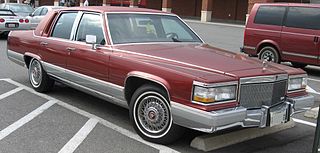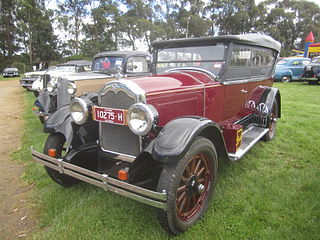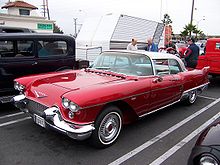
The Cadillac Motor Car Division is a division of the American automobile manufacturer General Motors (GM) that designs and builds luxury vehicles. Its major markets are the United States, Canada and China. Cadillac models are distributed in 34 additional markets worldwide. Historically, Cadillac automobiles were at the top of the luxury field within the United States, but have been outsold by European luxury brands including BMW and Mercedes since the 2000s. In 2019, Cadillac sold 390,458 vehicles worldwide, a record for the brand.

The Cadillac Eldorado is a luxury car manufactured and marketed by Cadillac from 1952 until 2002 over twelve generations.

The Cadillac V-16 was Cadillac's top-of-the-line model from its January 1930 launch until 1940. The V16 powered car was a first in the United States, both extremely expensive and exclusive, with every chassis being custom-finished to order. Only 4,076 were constructed in its 11-year run, with the majority built in its debut year before the Great Depression took strong hold. The onset of World War II reduced the sales, resulting in its demise. It was, however, at least three times cheaper than Bugatti Royale.

The Buick Roadmaster is an automobile that was built by Buick from 1936 until 1942, from 1946 until 1958, and then again from 1991 until 1996. Roadmasters produced between 1936 and 1958 were built on Buick's longest non-limousine wheelbase and shared their basic structure with the entry-level Cadillac Series 65, the Buick Limited, and after 1940, the Oldsmobile 98. Between 1946 and 1957 the Roadmaster served as Buick's flagship.

The Cadillac Brougham is a line of full-size luxury cars manufactured by the Cadillac Motor Car Division of General Motors from the 1987 through 1992 model years and was marketed from 1977 to 1986 as the Cadillac Fleetwood Brougham. The optional "d'Elegance" trim package that was introduced during the Fleetwood era remained available. The model received a facelift in 1990 and was replaced by the 1993 rear wheel drive D-body Cadillac Fleetwood.

The General Motors Motorama was an auto show staged by GM from 1949 to 1961. These automobile extravaganzas were designed to whet public appetite and boost automobile sales with displays of fancy concept cars and other special or halo models. Motorama grew out of Alfred P. Sloan's yearly industrial luncheons at New York City's Waldorf-Astoria Hotel, beginning in 1931. They were almost invariably held in conjunction with the New York Auto Show, that for many years was held traditionally in the first week of January.

The Cadillac Fleetwood is a full-size luxury sedan that was marketed by Cadillac from the 1976 to 1996 model years. Taking its nameplate from a coachbuilder historically associated with the General Motors division, the Cadillac Fleetwood became a stand-alone model line in 1985.

The Buick Limited was Buick's flagship model line between 1936 and 1942, and, in celebration of GM's Fiftieth Anniversary, a single-year halo car for the Division in model year 1958. Since the 1960s Buick has intermittently used the term "Limited" as a designation denoting its highest level of trim and standard features in its various model ranges.

The Cadillac Sixty Special is a name used by Cadillac to denote a special model since the 1938 Harley Earl–Bill Mitchell–designed extended wheelbase derivative of the Series 60, often referred to as the Fleetwood Sixty Special. The Sixty Special designation was reserved for some of Cadillac's most luxurious vehicles. It was offered as a four-door sedan and briefly as a four-door hardtop. This exclusivity was reflected in the introduction of the exclusive Fleetwood Sixty Special Brougham d'Elegance in 1973 and the Fleetwood Sixty Special Brougham Talisman in 1974, and it was offered as one trim package below the Series 70 limousine. The Sixty Special name was temporarily retired in 1976 but returned again in 1987 and continued through 1993.

The Cadillac Series 36-60 was Cadillac's entry-level product in the luxury vehicle market when it appeared in 1936, competing with the entry-level Packard Six. Each model year added the year prefix to the series in the number hierarchy used at the time. It was replaced by the Series 39-61 in 1939, but a model that was derived from it, the Sixty Special or 60S, continued off and on through 1993.

The Cadillac Series 70 is a full-size V8-powered series of cars that were produced by Cadillac from the 1930s to the 1980s. It replaced the 1935 355E as the company's mainstream car just as the much less expensive Series 60 was introduced. The Series 72 and 67 were similar to the Series 75 but the 72 and 67 were produced on a slightly shorter and longer wheelbase respectively. The Series 72 was only produced in 1940 and the Series 67 was only produced in 1941 and 1942. For much of the postwar era, it was the top-of-the-line Cadillac, and was Cadillac's factory-built limousine offering.

The Cadillac Series 40-62 is a series of cars which was produced by Cadillac from 1940 through 1964. Originally designed to complement the entry level Series 61, it became the Cadillac Series 6200 in 1959, and remained that until it was renamed to Cadillac Calais for the 1965 model year. The Series 62 was also marketed as the Sixty-Two and the Series Sixty-Two. The Series 62 was used to introduce the Cadillac Coupe de Ville and the Cadillac Eldorado which started out as special appearance packages that were later placed into production.

The Cadillac V8, introduced as the Type 51, is a large, luxurious automobile that was introduced in September 1914 by Cadillac as a 1915 model. It was Cadillac's first V8 automobile, replacing the four-cylinder Model 30, and used the all new GM A platform for the entire series shared with all GM division brands using a 122 in (3,099 mm) wheelbase, while a 145 in (3,683 mm) chassis was offered separately to be used for custom coachwork. The Types 53, 55, 57, 59, and 61 were introduced every year through 1923 with yearly improvements until an all new platform was substantially updated and introduced as the V-63 using the business philosophy called planned obsolescence. It was built at the Cass Street and Amsterdam Avenue factory in Detroit, with the coachwork provided by Fisher Body. The chassis could be purchased separately and sent to the clients choice of coachbuilder optionally.

The Cadillac V-63 is a large luxury automobile that was introduced in September 1923 by Cadillac as a 1924 model, replacing the previous Type 61. It used the GM C platform and was replaced by the Cadillac Series 355 in 1931. It retained the name Cadillac V8 introduced with the previous generation Cadillac Type 51.
Detroit Assembly was a General Motors automobile factory in Detroit, Michigan on Clark Street, south of Michigan Avenue. It began operations in 1921 and Cadillac bodies were supplied by Fleetwood Metal Body in 1921 after Fisher Body assumed operations. It was the second location that built Cadillacs, when Cadillac originally started out as the Henry Ford Company which was located at the intersection of Cass Avenue and Amsterdam Street. Engine block and cylinder heads were cast at Saginaw Metal Casting Operations then assembled at Tonawanda Engine before delivery to Detroit Assembly for installation.

The Pontiac Grand Safari was Pontiac's top-of-the-line full-size station wagon offered from 1971 to 1978. The Grand Safari used the grille and interior trim of the Bonneville and Grand Ville passenger car series, and most examples were trimmed with woodgrain paneling on the sides and tailgate.

The Cadillac Series 355 was a V8-powered luxury car manufactured by Cadillac from 1931 until 1935. It was offered as a 2-door club coupe, 2-door convertible, 4-door convertible, 4-door sedan, 4-door town car, and 4-door limousine. It provided a range of Cadillac below the maker's larger V-12 and V-16 lines. It was succeeded by the Cadillac Series 70/75.

The Cadillac DeVille is the nameplate used by Cadillac over eight generations, originally used to designate a trim level of the 1949 Cadillac Series 62 and later to designate a standalone model in the brand range. The last model marketed specifically as a DeVille was the 2005 full-size sedan, at the time, Cadillac's largest model.

The Buick Master Six, also denoted Series 40 and Series 50 based on the wheelbase used, was an automobile built by Buick from 1925 to 1928 and shared the GM B platform with the Oldsmobile Model 30. Previously, the company manufactured the Buick Six that used the overhead valve six-cylinder 242 cu in (4.0 L) engine in their high-end cars, and the Buick Four for smaller, less-expensive cars. Starting with 1918, they dropped the four-cylinder engine and designed a small six, which they called the Buick Standard Six, to replace that end of the market. They coined the name "Master Six" for the high-end cars, now powered by the 255 cu in (4.2 L) engine released the year before. The yearly changes were a result of a new business philosophy called planned obsolescence























